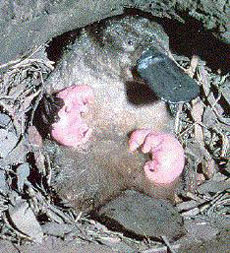Monotremata


Farewell summer, hail autumn. The approach of fall brings three radically different spectator sports to my immediate consciousness: playoff baseball, fantasy football, and law school faculty hiring. One biological taxon connects them all.
Monotremes, a mammalian order consisting of the platypus and four species of echidna, are best known and perhaps most succinctly described as egg-laying mammals.
 Oviparous reproduction makes monotremes the ideal emblem of sudden, unexpected, and heartbreaking failure. What? Is a baseball team once or now based in Boston fading in September? (Damn Yankees.) Did your fantasy team's two running backs combine for five yards from scrimmage and two fumbles? Did a candidate who looked great at the AALS combine bomb when called back to campus? Take them off your Dream Team, and put those egg-laying mammals on the 'Treme Team.
Oviparous reproduction makes monotremes the ideal emblem of sudden, unexpected, and heartbreaking failure. What? Is a baseball team once or now based in Boston fading in September? (Damn Yankees.) Did your fantasy team's two running backs combine for five yards from scrimmage and two fumbles? Did a candidate who looked great at the AALS combine bomb when called back to campus? Take them off your Dream Team, and put those egg-laying mammals on the 'Treme Team.Want more insults? They come quickly in this clade. Contemplate the cloaca, an anatomical feature that distinguishes monotremes from placental mammals. Nice etymology all around. The word monotreme combines the Greek words, μονο and τρεμα, for one and hole. A more appropriate name for a collection of bit players, whose output can be tabulated a sad series of binary digits, could not be contrived. And what exactly is a cloaca? Visitez le musée des égouts de Paris.
All kidding aside, monotremes rock. There are any number of reasons:
- Monotremes defy the English word mammal, which implies breasts, or at least nipples. Well, monotremes make milk but don't have nipples. Languages that call mammals by a term derived from the verb meaning suck -- for example, Germanic zoogdier (Dutch) and Säugetier (Ger.) and Slavic savec (Cz.) and ссавці (Ukr.) -- enjoy the taxonomic upper hand.
- Male platypuses are venomous, courtesy of their crural glands.
- Platypuses use electroception to locate prey by detecting electrical fields. This is a very rare stunt among mammals.
- In strictly technical terms, platypuses can and will kick your butt.
- Never mind the cloaca. The genetics of platypus reproduction will blow your mind. Not only is there multichromosomal meiosis; there's even evidence of evidence of an evolutionary link between avian and mammalian sex chromosomes, which were traditionally thought to have evolved independently. In other words, a male platypus carries a chain of five (!!!) XY chromosome pairs, XYXYXYXYXY, and those X's and Y's are connected in ways to the W's and Z's of birds that scientists had not expected.


One last set of observations regarding nomenclature is warranted. Monotremes are sometimes called Prototheria, in contrast with Metatheria (marsupials) and Eutheria (placental mammals). The sequence, one of the many rhetorical legacies of Thomas Huxley, means "first beast," "intermediary beast," and "true beast." Set aside the implicit calumny that oviparous reproduction implies lack of fitness -- birds, the only vertebrates that eschew ovovivaparous and vivaparous reproduction altogether, would beg to differ -- or the equally outrageous suggestion that placentas confer some sort of biological grace. The time will come for this forum to condemn the vulgar notion that evolution implies some sort of normative ladder, along the lines of the popular but frustrating blog rating service, The Truth Laid Bear. For now it suffices to note that Huxley's tripartite classification of mammals ignores the multituberculates, an extinct but once successful order that left a 100 million year-old fossil record -- the longest of any mammalian lineage.
All this is plenty to justify designating order Monotremata as the Jurisdynamics Network's taxon of the week.












2 Comments:
Alright, I give. If they produce milk, but don't have nipples, what *is* the delivery system??
Very interesting article, thanks!
From Wikipedia's article on monotremes:
Monotremes also lactate, but have no defined nipples, excreting the milk from their mammary glands via openings in their skin.
As I said, these critters are amazing.
Post a Comment
<< Home